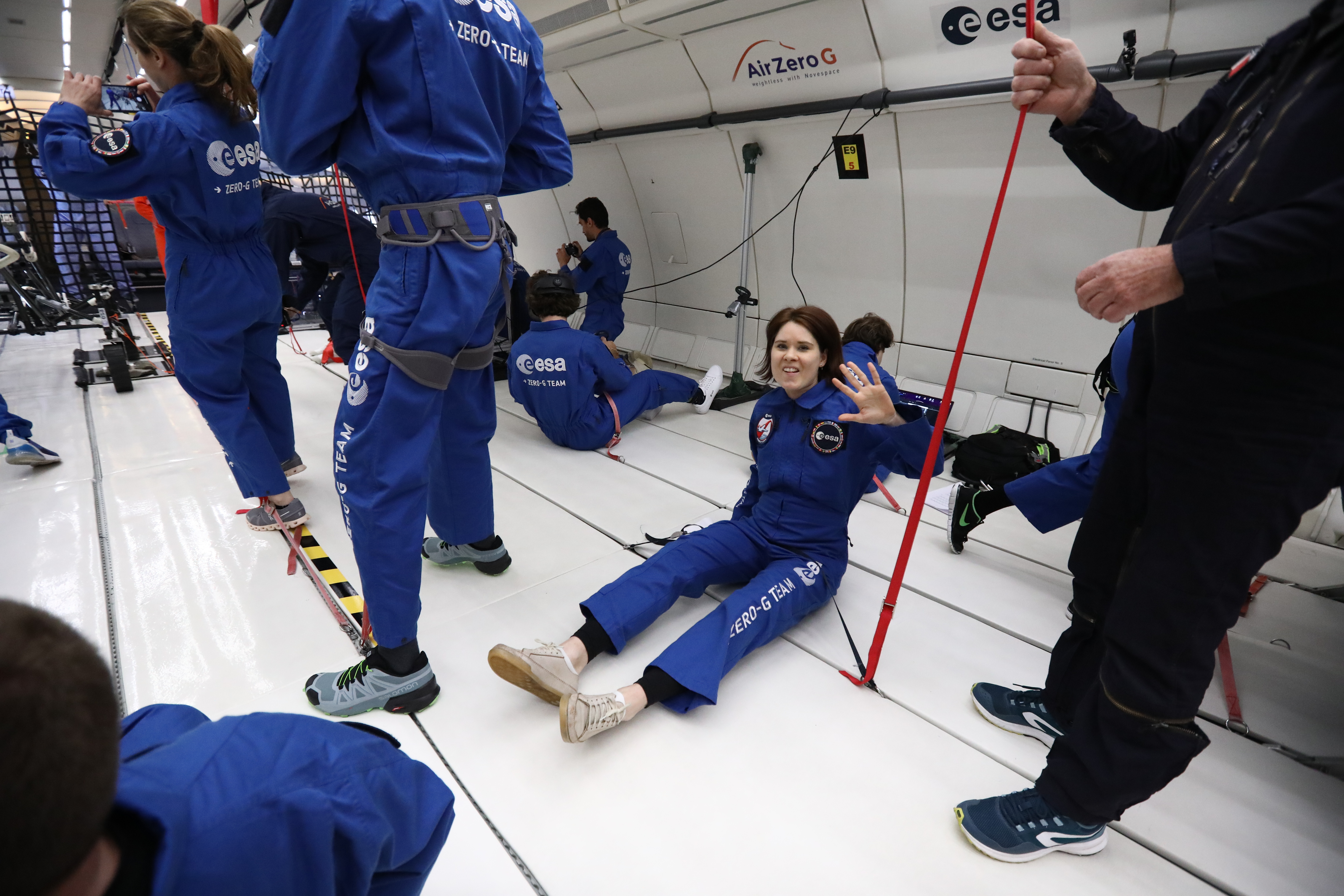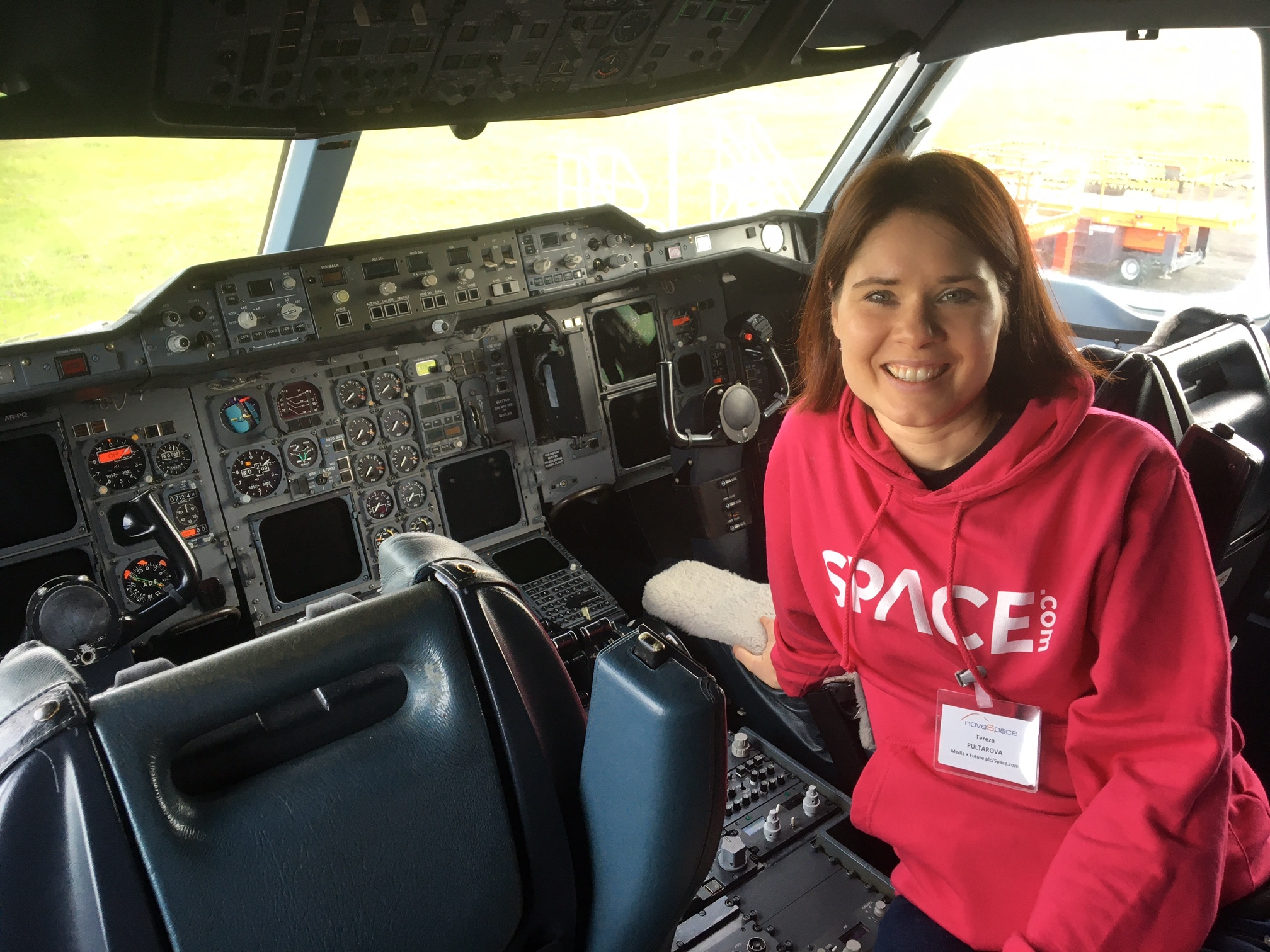Watch Space.com experience moon gravity at 30,000 feet in new mini-documentary out June 7
Experiencing low gravity for the first time isn't for the faint of heart.
Space.com's senior writer Tereza Pultarova can attest to that, having recently flown on a special flight designed to simulate the lower gravity of the moon for scientific research and astronaut training. Pultarova experienced lunar gravity during what's known as a parabolic flight, during which an aircraft performs a series of steep climbs and dives that create short periods of reduced gravity or even weightlessness. The aviators and crewmembers of these flights are some of the best test pilots the world has to offer.
To share the experience, Space.com is releasing a brand new documentary "Walking on the moon at 30,000 feet! Space.com trains like an astronaut in wild ride." The original film follows Tereza on her first lunar gravity parabolic flight during which she got to witness European Space Agency (ESA) astronauts testing new technologies designed for the moon.
You can watch the documentary on Space.com's homepage or on our YouTube channel starting at 11 a.m. ET (1500 GMT) on Wednesday (June 7). After the premiere, you can join our Q&A session with Tereza and the European Space Agency's parabolic flight coordinator Neil Melville.
To learn more about the parabolic flight and the making of the film, Space.com spoke with Tereza about what it was like to experience lunar gravity and get to witness ESA astronauts train for the moon.
Related: Watch an astronaut test a 'lunar wheelbarrow' in moon-like gravity for 1st time (exclusive video)
Read more: How do you create lunar gravity in a plane? A veteran zero-G pilot explains

Tereza is a London-based science and technology journalist, aspiring fiction writer and amateur gymnast. Originally from Prague, the Czech Republic, she spent the first seven years of her career working as a reporter, script-writer and presenter for various TV programs of the Czech Public Service Television. She later took a career break to pursue further education and added a Master's in Science from the International Space University, France, to her Bachelor's in Journalism and Master's in Cultural Anthropology from Prague's Charles University. She worked as a reporter at the Engineering and Technology magazine, freelanced for a range of publications including Live Science, Space.com, Professional Engineering, Via Satellite and Space News and served as a maternity cover science editor at the European Space Agency.
Space.com: What emotions were you feeling in the days or weeks leading up to the flight? What about right before the flight as you were boarding the plane?
Breaking space news, the latest updates on rocket launches, skywatching events and more!
Tereza Pultarova: For me, the emotions were extremely mixed from the first moment I got the offer to take part in the flight. First, it was excitement and gratitude and just 'wow, I can't believe this is happening.'
And then there was dread.
The truth is that I used to suffer from motion sickness big time as a child and I still have a tendency for it. Like I don't like to travel on London buses and rarely ever go on the upper deck. When I was a child, both my sister and I were the notorious kids with the sick bags that threw up during every school trip. And knowing that parabolic flights are sometimes nicknamed "the vomit comet," I was really worried about how I was going to handle it.
Space.com: What surprised you the most about the experience of lunar gravity and/or hypergravity?
Pultarova: Lunar gravity was awesome. I thought it would be like being in a bouncy castle or on a trampoline. But there is this added quality of everything being slowed down in moon gravity. So it felt like some sort of altered state of consciousness. For me, the biggest surprise was how intense the 2G phases [double Earth's gravity] were. You have 20 seconds of 2G before and after every half a minute of reduced gravity, so there was a lot of that. I mean, jet pilots have to handle much more. How do they do it?
Space.com: Did the experience change how you think/feel about what astronauts experience during spaceflight, moonwalks/spacewalks or reentry?
Pultarova: Yes; it's certainly great to experience this with your own body, because you do get a deeper understanding of all those challenges that spaceflight presents. Although what I found most difficult in this flight were the constant changes - 1G - 2G - moon G - 2G - 1G - and again and again, thirty times in only 2 hours. I wonder how it would feel if I had only one nice long reduced G phase and two intense hypergravity phases at the beginning and at the end.
Space.com: What was your favorite moment of the flight?
Pultarova: The first round of lunar G [moon gravity] parabolas was magical. You will see it in the documentary. I was like a kindergarten kid. But I also enjoyed the day before the flight when we were filming and interviewing and just having this great access to all these great people. I have been in science journalism for about 18 years now, reporting on space for about 10, and what I love about this work is the access you get. It's a huge privilege to be able to discuss the most cutting edge stuff with the most top notch people. So getting to discuss moon exploration training with the European Space Agency's chief astronaut trainer or sitting in the cockpit, talking to Europe's most senior parabolic flight pilot, those were my absolute 'kid in the candy store' moments.
And on top of that, French astronaut Thomas Pesquet was one of our pilots and I got to do a brief interview during the flight (just before the motion sickness took over; looking back at the interview, it had the potential to end up in the blooper of a century). And on top of that, it was my 40th birthday on the day of the flight. Almost too much good stuff ... Oh, and I forgot — just before the flight, I got a pep talk from Jean Francois Clervoy who was on one of the missions to fix the Hubble Space Telescope. Although you will only see him in the second documentary that we prepared.
Space.com: What do you hope people take away from watching your documentaries?
Pultarova: The first one, that you will see tomorrow, is mostly about my journey through the experience. The second is focused on the science and research reasons behind the flight.
These flights are not done for entertainment. The plane was packed with science experiments that will help humankind prepare for the challenges of moon exploration. But the experience was simply too rich to put into one video. We thought it would be too long, so we decided to split it up.
So overall, I hope that people will learn something watching them and get a little behind-the-scenes peek into the type of work that supports humankind's greatest exploration endeavor. We are likely going to live with the Artemis missions on the news pages for years to come, and these flights are part of the effort to make it all work.
And with projects like these, you always think that someone, somewhere will perhaps get intrigued or inspired and that it will perhaps affect the course of their lives positively and that thanks to that, they will have their own 'kid in the candy store' moments.

Brett is curious about emerging aerospace technologies, alternative launch concepts, military space developments and uncrewed aircraft systems. Brett's work has appeared on Scientific American, The War Zone, Popular Science, the History Channel, Science Discovery and more. Brett has English degrees from Clemson University and the University of North Carolina at Charlotte. In his free time, Brett enjoys skywatching throughout the dark skies of the Appalachian mountains.


